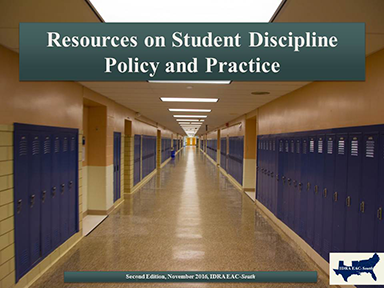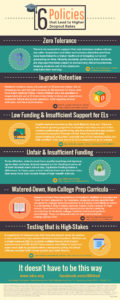High Attrition Rates of Black Students and Hispanic Students Are Linked to Exclusionary Discipline
News Release: San Antonio (December 1, 2016) – Zero tolerance policies likely contribute to high attrition rates of Black students and Hispanic students in Texas public schools. In an additional analysis to IDRA’s annual attrition study released earlier this month, IDRA compared the trend lines for attrition rates to those of discipline data for the state of Texas. The historical high attrition rate for each race-ethnicity group parallels the period when zero tolerance policies gained momentum in Texas. Lower attrition rates for each group coincide with Texas’ legislative attempts to relax zero tolerance approaches under specific circumstances.
Zero tolerance was originally used for drug enforcement, but it expanded in public schools into a policy of punitive and exclusionary consequences for student infractions, regardless of severity or circumstances. While zero tolerance practices vary, the general approach is the same: removing students who disrupt the learning environment. However, there is no research to support that zero tolerance makes schools any safer.
In Texas, data are collected on several types of disciplinary actions: in-school suspension, out-of-school suspension, referral to disciplinary alternative education programs (DAEP), referral to juvenile justice alternative education programs (JJAEP) and expulsion. A review of these data show disproportionately high disciplinary action rates for students of color and males.
“This has huge consequences as the data show nationally that children are up to 10 times more likely to drop out of high school if they’ve been expelled or suspended,” said Dr. María “Cuca” Robledo Montecel, IDRA president and CEO. “They also are much more likely to experience academic failure.”
IDRA’s analysis of school discipline data was released this month with its high school attrition study. Key findings show:
- Each year from 2005-06 to 2014-15 in Texas, Black students received in-school suspensions nearly two times the rate they comprised in the total population.
- While numbers of disciplinary actions have been declining in recent years, in 2014-15 there were 807,845 exclusionary discipline actions across Texas.
- Students in special education comprise 9.5 percent of the student population but make up 19.3 percent of out-of-school suspensions in 2014-15.
- Economically disadvantaged students comprise 61.2 percent of the student population but make up 81.5 percent of out-of-school suspensions and over 76.1 percent of in-school suspensions and DAEP actions in 2014-15.
- Students as young as 6 years old were removed from their kindergarten classes and sent to DAEPs for “discipline” problems. Many of their DAEP teachers are not qualified to teach them, and those who are qualified are unable to coordinate with the students’ “sending” schools.
It should be noted that expulsions and suspensions are in violation of civil rights laws if they are found to be administered in such a way that targets minority students.
 There are a number of things educators and policymakers in Texas can do to make sustainable changes that will reduce bias and help all students stay in school to learn. IDRA’s eBook, Resources on Student Discipline Policy and Practice, points to several tools and best practices for educators. This eBook was developed by the IDRA EAC-South, which is one of the four federally-funded equity assistance centers that help school districts build capacity to confront educational problems occasioned by race, national origin, sex and gender, and religion. Preceded by the IDRA South Central Collaborative for Equity, the IDRA EAC-South provides technical assistance and training to build capacity of local educators in multiple areas including reducing disproportionate school discipline for school districts cited by the Office for Civil Rights.
There are a number of things educators and policymakers in Texas can do to make sustainable changes that will reduce bias and help all students stay in school to learn. IDRA’s eBook, Resources on Student Discipline Policy and Practice, points to several tools and best practices for educators. This eBook was developed by the IDRA EAC-South, which is one of the four federally-funded equity assistance centers that help school districts build capacity to confront educational problems occasioned by race, national origin, sex and gender, and religion. Preceded by the IDRA South Central Collaborative for Equity, the IDRA EAC-South provides technical assistance and training to build capacity of local educators in multiple areas including reducing disproportionate school discipline for school districts cited by the Office for Civil Rights.
 Zero tolerance is one of six school policies that lead to higher dropout rates as outlined in IDRA’s latest infographic. The six policies are:
Zero tolerance is one of six school policies that lead to higher dropout rates as outlined in IDRA’s latest infographic. The six policies are:
- Zero Tolerance
- In-grade Retention
- Low Funding and Insufficient Support for English Learners
- Unfair and Insufficient Funding
- Watered-Down, Non-College Prep Curricula
- Testing that is High-Stakes
“Children do not make bad schools; Bad policies make bad schools,” said Dr. María “Cuca” Robledo Montecel. “The good news is that when it comes to transforming bad policies in education, we don’t need to take wild guesses: educators are already showing what works. The best, high-impact innovations value youth of all backgrounds, without exception; are built around sound information and metrics; engage families and communities as key partners in academic success; and assure that students have access to quality teaching and a high quality curriculum.”
IDRA’s Quality School Action Framework™ guides communities and schools in identifying weak areas and strengthening public schools’ capacities to graduate and prepare all students for success. IDRA’s book, Courage to Connect: A Quality Schools Action Framework™ shows how communities and schools can work together to be successful with all of their students.
IDRA’s attrition study and supplemental reports released this month are available online.
See interactive graphs and tables at our story site.
# # #
IDRA Resources Online
Infographic: 6 School Policies that Lead to Higher Dropout Rates
eBook: Resources on Student Discipline Policy and Practice
Article: In-Grade Retention in the Early Years – What’s Holding Children Back?
2016 Study – Texas Public School Attrition Study, 2014-16
Courage to Connect: A Quality Schools Action Framework
Related Stories
News Release (November 21, 2016): Texas High Schools Stand to Lose Over 2 Million Students in Coming Years
News Release (November 14, 2016): Temporary Policy Relieves High-Stakes for 6,000 Students
News Release (November 1, 2016): Despite Graduation Rate Progress, Texas Appears Stuck at Losing One-Fourth of High Schoolers


